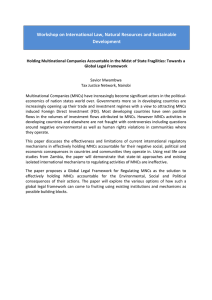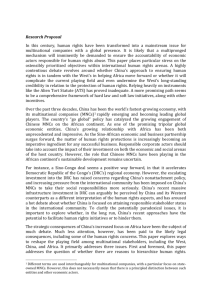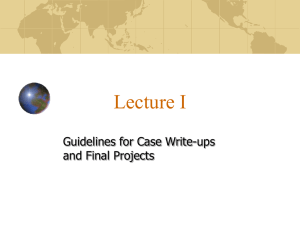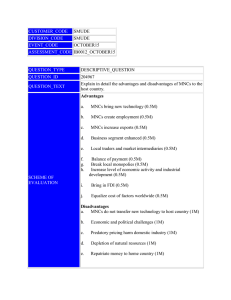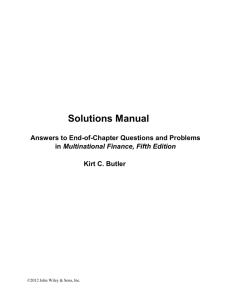Employment Practices of MNCs in Organisational Context: A Large-scale Survey
advertisement
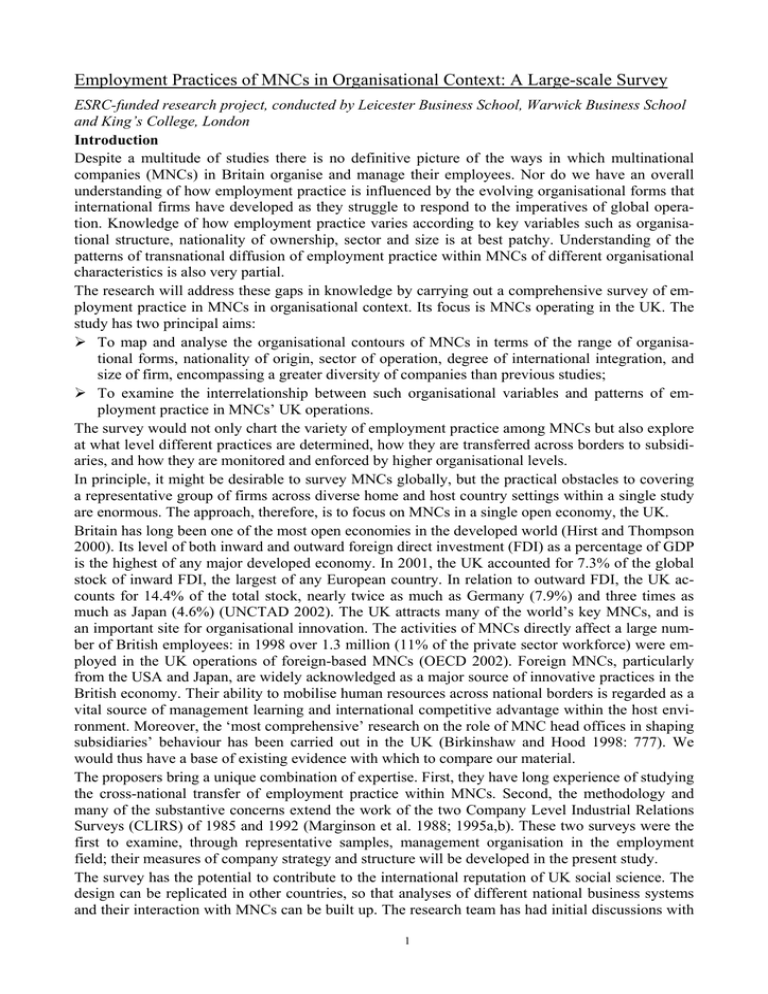
Employment Practices of MNCs in Organisational Context: A Large-scale Survey ESRC-funded research project, conducted by Leicester Business School, Warwick Business School and King’s College, London Introduction Despite a multitude of studies there is no definitive picture of the ways in which multinational companies (MNCs) in Britain organise and manage their employees. Nor do we have an overall understanding of how employment practice is influenced by the evolving organisational forms that international firms have developed as they struggle to respond to the imperatives of global operation. Knowledge of how employment practice varies according to key variables such as organisational structure, nationality of ownership, sector and size is at best patchy. Understanding of the patterns of transnational diffusion of employment practice within MNCs of different organisational characteristics is also very partial. The research will address these gaps in knowledge by carrying out a comprehensive survey of employment practice in MNCs in organisational context. Its focus is MNCs operating in the UK. The study has two principal aims: ¾ To map and analyse the organisational contours of MNCs in terms of the range of organisational forms, nationality of origin, sector of operation, degree of international integration, and size of firm, encompassing a greater diversity of companies than previous studies; ¾ To examine the interrelationship between such organisational variables and patterns of employment practice in MNCs’ UK operations. The survey would not only chart the variety of employment practice among MNCs but also explore at what level different practices are determined, how they are transferred across borders to subsidiaries, and how they are monitored and enforced by higher organisational levels. In principle, it might be desirable to survey MNCs globally, but the practical obstacles to covering a representative group of firms across diverse home and host country settings within a single study are enormous. The approach, therefore, is to focus on MNCs in a single open economy, the UK. Britain has long been one of the most open economies in the developed world (Hirst and Thompson 2000). Its level of both inward and outward foreign direct investment (FDI) as a percentage of GDP is the highest of any major developed economy. In 2001, the UK accounted for 7.3% of the global stock of inward FDI, the largest of any European country. In relation to outward FDI, the UK accounts for 14.4% of the total stock, nearly twice as much as Germany (7.9%) and three times as much as Japan (4.6%) (UNCTAD 2002). The UK attracts many of the world’s key MNCs, and is an important site for organisational innovation. The activities of MNCs directly affect a large number of British employees: in 1998 over 1.3 million (11% of the private sector workforce) were employed in the UK operations of foreign-based MNCs (OECD 2002). Foreign MNCs, particularly from the USA and Japan, are widely acknowledged as a major source of innovative practices in the British economy. Their ability to mobilise human resources across national borders is regarded as a vital source of management learning and international competitive advantage within the host environment. Moreover, the ‘most comprehensive’ research on the role of MNC head offices in shaping subsidiaries’ behaviour has been carried out in the UK (Birkinshaw and Hood 1998: 777). We would thus have a base of existing evidence with which to compare our material. The proposers bring a unique combination of expertise. First, they have long experience of studying the cross-national transfer of employment practice within MNCs. Second, the methodology and many of the substantive concerns extend the work of the two Company Level Industrial Relations Surveys (CLIRS) of 1985 and 1992 (Marginson et al. 1988; 1995a,b). These two surveys were the first to examine, through representative samples, management organisation in the employment field; their measures of company strategy and structure will be developed in the present study. The survey has the potential to contribute to the international reputation of UK social science. The design can be replicated in other countries, so that analyses of different national business systems and their interaction with MNCs can be built up. The research team has had initial discussions with 1 colleagues in other countries, and if the proposal is successful will actively encourage the replication of the research elsewhere. Academic rationale The theoretical rationale for the proposed survey covers three interrelated concerns. First, the management literature has described a variety of evolving models of MNC organisation as companies respond to the requirements of operating in an international economy. Research has pointed, for example, to the emergence of ‘multi-centred’ or ‘heterarchic’ firms in which strategic responsibilities are widely disseminated and in which the coordination of ‘differentiated networks’ becomes a key management task; to the accompanying growth of horizontal linkages involving innovative project- and team-based forms of international organising; and to the strengthening of international structures based on regions and business divisions (Bartlett and Ghoshal 1990; 1998; Hedlund 1986; Malnight 2001; Pettigrew and Massini 2001). These developments have stimulated a wide variety of intermediate structures and modes of organising management functions, including human resources, at international level (Edwards et al. 1996; Ferner et al. 2002). At the same time, the organisational structures of firms rooted in different national business systems continue to display major differences (Whittington et al. 1999; Whitley 1999). These evolving and diverse developments have profound implications for how different MNCs manage employment practices in their subsidiaries. With MNCs increasingly seeing their British operations as part of a cross-border web of operations serving regional and world markets, are employment practices responding to a corporate logic extending beyond the confines of the British economy (Marginson 2000)? Is a truly ‘European’ or indeed global MNC emerging? How far are there standard systems of career management? Do MNCs monitor subsidiaries against performance targets across operations and use this as the basis for cross-national organisational benchmarking? Second, a wide-ranging debate has looked at the potential for cross-national diffusion of employment practice, including ‘reverse diffusion’ from foreign subsidiaries to domestic operations (Edwards and Ferner 2003). MNCs may be seen as the key mechanism for disseminating competitive policies across borders. Given the potential of Britain’s ‘liberal market economy’ (Hall and Soskice 2001) as a site for experimentation, foreign MNCs may be able to introduce innovative practices and these may in turn be ‘reverse-diffused’ to operations elsewhere. In short, the UK is a good site for researching cross-national diffusion of employment practice within MNCs. The survey will throw light on the range and incidence of different practices, their origins, and their movements across national borders. It will also explore the mechanisms through which such transfers take place, in particular innovative structures such as cross-national horizontal networks within firms. Third, research on the international dissemination of organisational forms and employment practices is relevant for the broader ‘convergence’ debate: is business practice converging among MNCs (particularly within more globally competitive industries)? Or does practice remain divergent across different kinds of firm, shaped by national-institutional and other factors (Harzing and Sorge 2003)? The proposed survey will contribute to this debate by showing how far practices in foreign MNCs resemble each other and those of their British counterparts, and how far practices originate outside the UK. Given the relatively low pressure for local ‘institutional isomorphism’ within the UK business system, an observed similarity of employment practice among different kinds of MNC may be taken as prima facie support for the convergence thesis; conversely systematic variations in practice among MNCs of different nationality may be taken as indicative evidence that MNCs remain shaped by distinctive characteristics of their native business systems. Despite the theoretical and practical importance of these issues, there is a striking lack of comprehensive survey data on employment practices in MNCs in the UK. Existing survey-based studies have usually been restricted in a number of respects. Some have been ‘spin-offs’ from the periodic WERS surveys (e.g. Buckley and Enderwick 1985; Milner and James 1994), or the present proposers’ CLIRS surveys (e.g. Purcell et al, 1987); numbers of MNCs have been limited. Others have focused on acquisitions (e.g. Child et al. 2000), greenfield sites (e.g. Guest and Hoque 1996), MNCs headquartered in one country (e.g. Beaumont et al. 1990; Dunning 1998), or specific issues 2 such as decentralisation (Young et al. 1986) or management control (Harzing 1999). The proposed survey will be the largest and most comprehensive investigation in Britain of MNCs’ employment practices, based on what we believe to be the first systematic listing of MNCs operating in the UK. Preparatory work This proposal builds on preparatory work, funded by Warwick and De Montfort Universities, to establish a population of MNCs with UK operations (Arrowsmith 2002). Prior to this, no suitable sampling frame existed. It took five months’ detailed work, starting from FAME, Amadeus and other databases and then checking individual records, to construct two populations: 1. All overseas-owned MNCs operating in the UK, with 500 or more employees world-wide and 100 or more in their UK operation. 2. All UK-owned MNCs with 500 or more employees world-wide and at least 100 overseas. The dual employment threshold parallels the approach of the EU’s Directive on European Works Councils (94/45/EC) in defining ‘European-scale’ (multinational) companies. The 500 employee threshold provides coverage of medium as well as large-sized MNCs; the 100 employee threshold was determined by pragmatic considerations of data reliability on smaller operations and to focus on production and service, as distinct from purely sales, operations. This exercise resulted in a listing of 2,525 overseas-owned MNCs with UK operations (after consolidating multiple UK subsidiaries of the same parent company) and of 577 UK-owned MNCs, together with a further 282 companies whose status remains unclear. Data were also collated on nationality of the parent, sector, employment, location of overseas subsidiaries (UK MNCs only), turnover and UK contact details. Annexe 4 provides a breakdown of the overseas-owned MNCs by main country of origin. The survey It is proposed to carry out the survey in two stages over a 30-month period beginning in October 2004 (see Annexe 2 for details of proposed work schedule). Before proceeding with the main survey, it is necessary to screen the initial listing for reliability, to resolve discrepancies between different published databases, and to attribute nationality and establish compliance with the employment thresholds in ambiguous cases. Moreover, it is known from previous case-study research that the UK operations of many overseas-owned MNCs are complex, for example embracing more than one business of the parent company within separate subsidiaries, making it difficult to identify an appropriate respondent for a survey of UK operations without further screening. Phase I: Telephone screening survey A specialist survey firm will be employed to carry out a screening survey of the MNC population, using 15-minute telephone interviews with senior personnel respondents in UK operations of foreign MNCs and in head offices of UK-owned MNCs. The proposers’ past experience from CLIRS suggests good response rates (around 80 per cent) for such methods. The aim of the telephone screening is threefold. First, it will verify and check the results of the preparatory listing so as to establish a reliable sampling frame for the main survey. Second, it will identify an appropriate respondent capable of commenting authoritatively on practice within the UK and (for foreign-owned companies) on the degree of discretion granted by overseas HQs. Third, it will continue the successful practice of CLIRS of exploring some significant substantive issues (see Annexe 3 for draft screening questionnaire). Particular attention will be paid to mapping organisational structures of MNCs, including the role of intermediate levels such as European regional head offices and international business divisions. Phase II: Full-scale survey of UK- and foreign-owned MNCs in Britain The main survey will explore organisational characteristics and the management of employment practices in overseas- and British-owned MNCs in the UK. It will comprise a sample of the population of MNCs detailed in the initial listing, as revised following the telephone screening phase. The sample will be stratified by the principal countries of origin amongst overseas-based MNCs operating in the UK (the US, Germany, the Netherlands, the Nordic area, France and Japan – see Annexe 4) to generate adequate numbers from each for analysis. Inclusion also of a similar number of UK3 based MNCs will provide a reference against which the distinctiveness of (different) nationalities of origin can be assessed. It is also necessary to cover MNCs based elsewhere in the rest of a) Europe and b) the world. This produces a set of 9 different ‘sites’ or origin. With 50 companies in each group, the target is a total of 450 completed interviews. The response rates for CLIRS1 and 2 were 43 and 28 per cent respectively, but the second survey called for matched interviews with two senior managers (including a finance director); in the present study we anticipate a rate of at least 40 per cent. The respondent will be the senior manager with HR responsibilities in the UK, as identified in Phase I. Using a structured questionnaire which will have been rigorously piloted, the survey will focus on the following principal questions: ¾ What are the contours of organisation of MNCs in the UK, in terms of organisational structures, degree of international integration of operations, size, sector and country of ownership? ¾ What pattern of employment practice exists in different types of MNC in the UK? The survey will pay particular attention to the processual features of employment practice, exploring such questions as how different practices are diffused internationally in MNCs with different characteristics, and the degree of subsidiary autonomy in the design and implementation of employment practices. It will permit the testing of competing hypotheses, as illustrated below. Organisation: structure and process In relation to structure, the survey will identify such key variables as: number of employees (UK and globally); age of company and timing of multinational development; main sector of operation; the degree of diversification; the extent to which business divisions are organised on a crossnational basis; location of HQ and key subsidiary units; and composition of the board of directors. Measures of internal organisation comprise both formal and informal arrangements. The former include the extent of standardised hierarchical decision-making; the issuing of policy directives; and the use of management control and planning systems. The latter include the use of expatriates; and more network-based structures such as international project groups and task forces. Some important hypotheses are essentially binary in nature. Much of the literature on MNCs speaks of a shift in orientation towards the global and away from a ‘multi-domestic’ approach, Similarly, ideas of network-based and learning-oriented organisations are common. To what extent do MNCs generally reflect these ideas? Have traditional ‘command-and-control’ systems been supplanted or complemented by new approaches? A combination of local flexibility and a ‘strong centre’ is a popular model (Birkinshaw 2002). A set of indicators of global orientation and internal organisation will be developed, so that different dimensions of relevant behaviour can be mapped, and the linkages between central direction and local autonomy examined. In bi-variate terms, the smaller and newer MNCs, for example, may be the least likely to be globalised in orientation. Patterns of employment practice In relation to employment practice, the objective is three-fold: to identify the main ways in which MNCs motivate, develop and communicate with employees; to establish how far there is an international or a global dimension to these activities; and to use the UK as an example of how MNCs develop competitive advantage within a particular national business environment. The CLIRS research showed clear associations between company structure and organisation and employment practice. For example, conglomerate companies were the least centralised and standardised on a range of employment issues; MNCs organised along international business lines were more likely to have international personnel management structures and networks than their multidomestic counterparts. Similar hypotheses will structure the present analysis. Four substantive areas of employment practice have been selected for detailed exploration. They are chosen not only as fundamental aspects of employment practice but also because they cover a range of issues from more ‘global’ to more ‘local’, including those subject to strong local influences as well as those for which MNCs have more scope to introduce global policies. 4 1. PERFORMANCE MANAGEMENT AND REWARD SYSTEMS. The survey will assess whether models of performance management are converging, or whether MNCs continue to reflect the influence of the distinctive models of performance management of their parent business systems. ‘Performance management’ systems are taken to encompass mechanisms for defining performance objectives for employees, both in terms of behaviours and outputs, for monitoring progress, and for appraising performance against targets; they are closely allied to reward systems which are increasingly seen as key instruments for driving performance. Rosenzweig and Nohria (1994) argue that reward systems, as opposed to pay determination, are only weakly susceptible to pressure from the host environment and are therefore likely to exhibit external influences. Foreign MNCs, particularly from the USA, have long been associated with the transfer of innovative pay and performance management systems to the UK. ¾ Are MNCs converging on global, possibly ‘Anglo-Saxon’, performance management models? ¾ Are models of performance management internationally standardised within MNCs? ¾ Are performance management policies in UK operations reverse-diffused to other parts of the MNC? If so, through what mechanisms does such ‘organisational learning’ take place? 2. LEARNING AND DEVELOPMENT. Research suggests that employee learning and development play a critical role in focusing capabilities for competitive purposes (e.g. Bird et al. 1998), particularly as MNCs attempt to move beyond mechanistic formal systems of training to encompass more ‘learner-led’ modes, emphasising the contributions of non-managerial employees to international knowledge transfer. The concern of MNCs with the competitive advantage deriving from learning (e.g. Birkinshaw and Morrison 1995; Doz and Prahalad 1986) suggests that cross-national training and learning systems may be emerging within these firms. However, much literature points to the critical influence of distinctive national institutions of learning and skill acquisition (e.g. Brown and Duguid 1991; Goodrick and Salancik 1996). ¾ What different strategies are adopted for cross-national learning within MNCs? ¾ How far are learning strategies influenced by different home-country institutional models of learning and skills acquisition, and how do such models interact with the UK environment? ¾ Through what mechanisms is learning diffused across different kinds of MNC? 3. EMPLOYEE REPRESENTATION. Employee representation in MNCs has tended to be shaped by local legislation, institutions and customs and therefore to be relatively less susceptible to parent influence than some other areas of employment practice (Milner and James 1994). The establishment of transnational structures of employee representation under the requirements of the 1994 European Works Councils directive – implemented in the UK in 2001 – adds a new dimension, with the potential for ‘knock-on’ effects where EWCs are established in the absence of national or local structures of representation. EWCs are one element of growing EU pressure for employeebased representative structures for information and consultation, culminating in the adoption in 2002 of the directive on national information and consultation. In anticipating its implementation in an environment where there is no such domestic tradition, a key issue is in what ways, if any, MNCs will draw on experience of such structures in other European countries. ¾ Do patterns of representation differ between MNCs headquartered in different countries? ¾ How are MNCs responding to the EWC requirement and to the pending national information and consultation requirement? 4. EMPLOYEE INVOLVEMENT AND COMMUNICATION. In addition to indirect forms of employee involvement, direct participation (DP) will be addressed, drawing on the Employee Direct Participation in Organisational Change (EPOC) survey across 10 European countries (Sisson 1997). That survey (whose questionnaire design group included 2 members of the present team) was workplacebased and identified 6 main forms of DP. For analysis at company level, two aspects are central. The first is the adoption of new models of involvement in the workplace itself, especially in relation to work organisation and the extent of teamwork. Research to date identifies this area as one of similar practice across countries. The survey will test this proposition, and also identify how a model of work organisation is diffused across and within MNCs. Second, by contrast, national dif5 ferences have been noted in relation to more general policy on involvement in such areas as communication and information. Many US firms, particularly those with a ‘welfare capitalist’ style (Jacoby 1997), have attached great importance to direct communication, e.g. employee attitude surveys. However, the evidence on the effects of such policies on concrete behaviour in the UK is patchy, as is information on the extent to which MNCs from other countries use communication as a strategic tool. Thus the survey will address: ¾ The extent of adoption of new models of involvement-based work organisation, the ways in which such models are identified and diffused, and variations (e.g. by country of origin and sector) in the degree to which MNCs adopt central corporate policies. ¾ Whether there are systematic differences in communication and involvement policy between MNCs of different nationality. In addressing these four areas, the study will be structured around three key groups of employees. - First, managers are widely seen as a key group in MNCs: the identification of key managers, and the provision of international career development that will generate skills and experience, are central features of MNC operation. Where companies have a policy of developing a cadre of ‘international managers’ to promote cross-border integration of strategy and operations, one might expect special emphasis on the international management of remuneration and career development for managers, with non-managerial staff subject to fewer internationally standardised practices. In contrast, in sectors where large international customers expect uniform global standards of service, greater attention to the practices of non-managerial staff may be expected. - Second, a simple distinction between managers and other employees may be too stark. Firms may have other key groups of employees, for example research staff or product designers, who are critical to organisational learning and competitive advantage. - Third, non-managerial employees, in line with growing evidence that these are affected by the cross-border context of local employment practice. In practical terms, following other surveys, the ‘largest occupational group’ (LOG) will be identified. The aim is not to chart details of employment policy for every group across every issue. Instead, the groups will be used as concrete examples for the four substantive areas, as appropriate. Managers will provide the focus for areas 1 and 2. For example, what are the key performance measures for managers internationally, and has UK experience provided examples of the diffusion of performance management systems? For other staff, the central questions are which staff are managed with an international perspective and how learning takes place. For example, recent research on Japanese MNCs suggests that the competitive advantage of transferring practices from Japan may be eroding, and that, instead, firms have to look to countries like the UK for R&D capabilities (Morgan et al. 2002). The extent to which MNCs operate in this way will be assessed, and linked to different national origins and sectors (e.g. is diffusion via R&D more of a manufacturing than a service sector phenomenon?) The LOG will be used as a focus for areas 2-4. For example, how far do international policies on learning and development trickle down to this group, or is it managed primarily as a national resource? What aspects of involvement and communication are shaped internationally in the MNC? Conclusion The survey, building on the insights of qualitative research, will create a unique resource for academic researchers, practitioners and policy-makers in the UK, as well as a template promoting comparative exploration and the development of cross-national generalisation in the future. It will generate unparalleled data on the interplay between nationality of ownership, sector and organisational variables as they affect employment in MNCs, and will illuminate such key debates as globalisation and divergence, the scope for cross-national diffusion of practices, and the nature of organisational learning in MNCs. 6 Annexe 1 References Arrowsmith, Jane 2002 ‘MNC Databases – Report on Data Gathering’, Project Team Report. Bartlett, C. and Ghoshal, S. 1990 ‘The multinational organisation as an interorganizational network’ Academy of Management Review, 15, 4, 603-625. Bartlett, C. and Ghoshal, S. 1998 Managing Across Borders, The Transnational Solution. 2nd Ed. London: Hutchinson. Beaumont, P. et al. 1990 ‘Key industrial relations: West German subsidiaries in Britain’, Employee Relations, 12/6 3-7. Bird, A., Taylor, S., Beechler, S. 1998 ‘A Typology of International Human Resource Management in Japanese Multinational Corporations’, Human Resource Management, 37, 2, 159-172. Birkinshaw, J. 2002. ‘How Long Division Can Add Up to Bigger Numbers’, Financial Times, 7 August. Birkinshaw, J. and N. Hood. 1998. ‘Multinational Subsidiary Evolution’, Ac. of Management Review, 23: 773-95. Birkinshaw, J. and Morrison, N. 1995 ‘Configurations of Strategy and Structure in Subsidiaries of Multinational Corporations’, Journal of International Business Studies, Fourth Quarter, 729-753. Brewster, C. and Hegewisch, A. (eds) 1994 Policy and Practice in European Human Resource Management. The Price Waterhouse Cranfield Survey. London: Routledge. Brown, J. S. and Duguid, P. 1991 ‘Organizational learning and communities of practice: toward a unified view of working, learning and innovation’. Organization Science, 2, 1, 40-57. Buckley, P. and Enderwick, P. 1985. The Industrial Relations Practices of Foreign-owned Firms in Britain. Macmillan. Child, J., Falkner, D. and Pithethly, R. 2000 The Management of International Acquisitions, Oxford: OUP. Doz, Y. L. and Prahalad, C. K. 1986 ‘Controlled Variety: A Challenge for Human Resource Management in the MNC’. Human Resource Management, 25, 1, 55-72. Dunning, J. 1998 (1958) American Investment in British Manufacturing. 2nd edn. London & New York: Routledge. Goodrick, E and Salancik, G. R. 1996. ‘Organizational discretion in responding to institutional practices: hospitals and caesarian births’. Administrative Science Quarterly, 41, 1-28. Guest, D. and Hoque, K. 1996. National ownership and HR practices in UK greenfield sites’, HRMJ, 6, 4, 50-74. Hall, P. and Soskice, D. 2001. ‘An introduction to varieties of capitalism’, in P. Hall & D. Soskice (eds), Varieties of Capitalism, Oxford: OUP, 1-68. Harzing, A.-W. 1999 Managing the Multinationals: an international study of control mechanisms. Cheltenham: E Elgar. Harzing A. W. and Sorge, A 2003 ‘The Relative Impact of Country-of-Origin and Unviersal Contingencies on Internationalization Strategies and Corporate Control in Multinational Companies’ Organization Studies (forthcoming) Hedlund, G. 1986 ‘The Hypermodern MNC’, Human Resource Management, 25, Spring, 9-36. Hirst, P. and Thompson, G. 2000 ‘Globalization in one country?’ Economy and Society, 29, 3, 335-56. Jacoby, S. 1997 Modern Manors: Welfare Capitalism since the New Deal, Princeton, NJ: Princeton University Press. Malnight, T. 2001 ‘Emerging structural patterns within multinational corporations: Toward process-based structures’, Academy of Management Journal, 44, 6, 1187-1210. Milner S and James A 1994 ‘Foreign Ownership, Unionisation and Collective Bargaining’ Centre for Economic Performance, LSE. Working Paper No. 592 Morgan G., Sharpe D., Kelly D. and Whitley R. 2002 ‘The future of Japanese manufacturing in the UK’ Journal fo Management Studies 39, 8, 1023-44. OECD 2002 Measuring Globalization: the Role of Multinationals in OECD Economies Paris: OECD ONS 1995 Manufacturing. Production and Construction Inquiries – Summary Volume. PA 1002. London: ONS. Pettigrew, A. and Massini, S. 2001 ‘The adoption of innovative forms of organizing in Europe and Japan in the 1990s’. In J. Gual and J. Ricart (eds) Strategy, Organization and the Changing Nature of Work, Edward Elgar, 169-200. Purcell, J., Marginson, P., Edwards, P. and Sisson, K. 1987 ‘The Industrial Relations Practices of Multi-Plant Foreign Owned Firms’ Industrial Relations Journal 18, 2, 130-37 Rosenzweig P and Nohria N 1994 ‘Influences on Human Resource Management Practices in Multinational Corporations’ Journal of International Business 25, 2, 229-51 Sisson K 1997 Towards new forms of work organisation: can Europe realise its innovative potential? Luxembourg: Office for the Official Publications of the European Communities UNCTAD (United Nations Commission on Trade & Development) 2002 World Investment Report. NY/Geneva: UN. Whitley, R., eds. 1999 Divergent Capitalisms: the Social Structuring and Change of Business Systems. Oxford: OUP. Whittington, R., Mayer, M. and Curto, F. 1999 ‘Strategy, structure and performance in European industry’ in S. Quack et al. (eds) National Capitalisms, Global Competition, and Economic Performance, Am’dam: John Benjamins, 105-30. Young, S., Hood, N. and Hamill, J. 1985. Decision-making in foreign-owned multinational subsidiaries in the United Kingdom. Multinational Enterprises Programme, Working paper 35. Geneva: ILO. 7 Annexe 2 Schedule of work The duration of the project is two-and-a-half years. The initial phase of the project, lasting 6 months, will involve: selection of the fieldwork contractor; preparing and conducting the telephone screening; and drafting the questionnaires for the main survey. The second phase, from months 7 to 12, will prepare the main survey, using the results of the telephone screening to construct the sample and refine the questionnaire before piloting the survey instruments. The main survey fieldwork will be conducted between months 13 and 15, with a dataset being supplied to the research team by the end of month 15. Initial analysis, aimed at mapping the major features of employment practice and variation between different types of MNC, will take from months 16 to 21. Further analysis, pursuing particular analytical and empirical themes, will follow over the final nine months. Three different kinds of variation will be pursued. A first line will investigate the respective importance for employment practice of differences between MNCs in nationality of origin; sector; size; and organisational configuration, including degree of international integration. A second line will take substantive practices, examining variation in the extent to, and form in, which different areas of employment practice are subject to cross-border influence within MNCs. A third line will differentiate between three selected groups within the workforce, comparing and contrasting practice towards each. In each instance, multi-variate analysis utilising appropriate regression techniques will build from initial bi-variate analysis. Annexe 3 Draft screening questionnaire We are carrying out a study for the University of Warwick Business School, De Montfort University Business School and King’s College London’s Management Centre, about the management of human resources in multinational companies. I have some very quick questions about the organisation of your company and the place of HR issues. 1. Can I just check that this is the highest level of your company in the UK, that is that you do not have a parent company in the UK? IF PART OF A LARGER ENTERPRISE: What is this enterprise? [obtain name, address, etc and close interview] IF HIGHEST UK LEVEL, GO TO Q2 2. And is this the overall HQ of your enterprise in the UK? IF NO: Where is the HQ? [establish details, and close] IF YES: GO TO Q3 3. Approximately how many employees does the enterprise have in the UK? 4. And what is your TOTAL worldwide employment? 5. Is the enterprise UK or overseas owned? IF OVERSEAS: What is the nationality of ultimate holding company [UHC]? [name of country = Country A below]. 6. Thinking of the structure of the enterprise within the UK, does the company have levels such as divisions, business lines, operating companies, or SBUs that are intermediate between the HQ and operating units? IF YES: 6a. what is your usual term for such a level? RECORD NAME AND USE FOR ‘DIVISION’ BELOW 6b. roughly how many divisions do you have? 6c. Do these divisions operate within the UK or internationally? ALL/MOST/SOME/NONE ARE INTERNAT. IF ANY INTERNAT.: 6d. Are the head offices of these divisions located outside the UK? ALL/MOST/SOME/NONE 7. Thinking of the relationship between the UK HQ and operating units in HR matters, which of the following statements comes closest to describing the relationship? [operating unit = the lowest main operating unit, e.g. a site or branch] • We draw up an overall policy and exercise strict control over how it is implemented in operating units • We draw up an overall policy and exercise strict control over how key issues are implemented while leaving others to operating units • We draw up an overall policy but leave operating units to put it into practice • There is no real overall policy; employee relations are left to the operating units 8. Turning to the world-wide structure of your company, and thinking of the main board of the company: Is there a member of the board whose main responsibility is HR? IF NO: 8a. is HR a specifically designated part of the role of a member of the board? 8b. Roughly what proportion of board members are not UK nationals / not nationals of Country A. 9. Roughly how many divisions does the world-wide enterprise have? 10. How many of these have significant operations outside any one country? 11. Would you say that the company’s world-wide structure is organised mainly around national subsidiary companies, or divisions with an international focus, or both? IF BOTH: 11a. Is this because some activities are nationally organised while others are based on international divisions? By ‘activities’ I mean different tasks of the business e.g. regulatory compliance may be national while marketing is ID-based. IF YES: 11b. roughly what is the split between national and ID operations? MOSTLY NAT / 50-50 / MOSTLY ID IF NO: 11c. is this because functions are shared between national subsidiaries and IDs? IF NO: 11d. could you explain briefly the division of responsibilities? IF MAINLY NATIONAL OR BOTH AT Q11: 12. How would you characterise the relationship between the HQ of the UHC and national subsidiaries? READ OUT AND CODE ONE • HQ establishes overall strategy which is implemented locally • HQ sets main strategic direction and leaves application to subsidiaries • HQ sets minimal general principles and leaves policy mainly to subsidiaries • HQ leaves formulation of policy to subsidiaries IF MAINLY INTERNAT. DIV. OR BOTH AT Q10: 13. How would you characterise the relationship between the HQ of the UHC and international divisions? READ OUT AND CODE ONE • HQ establishes overall strategy which is implemented locally • HQ sets main strategic direction and leaves application to subsidiaries • HQ sets minimal general principles and leaves policy mainly to subsidiaries • HQ leaves formulation of policy to subsidiaries 14. Does your company have organisational units between the HQ of the UHC and national subsidiaries, such as European or North American regional centres or regional companies? IF YES, AND NOT NATIONAL SUBSIDIARIES ONLY AT Q11: 14a. would you say that the primary organisational unit is the regional one or international product divisions? REGIONAL / INTERNAT. PROD. / BOTH IF BOTH AT 14a: 14b. could you explain briefly are the main responsibilities of regions and IDs? 15. Finally, this study is part of a project examining HR strategy in a representative sample of MNCs. Would you be prepared to take part in a fuller interview on these issues? Annexe 4 Breakdown of Warwick/Leicester Business School MNCs database by country of origin Country USA Germany Netherlands Nordic area Sweden Denmark Norway Finland France Japan Switzerland Others Unresolved Total no. of MNCs in UK 908 185 160 128 44 42 26 16 125 123 80 704 112 2525 Source: Arrowsmith 2002 and associated database. The figures are after consolidating multiple UK subsidiaries of the same parent company. Annexe 5 Research Team Professor Anthony Ferner (joint project leader) Professor Paul Marginson (joint project leader) Professor Paul Edwards Dr Tony Edwards Dr Olga Tregaskis Department of HRM, Leicester Business School, De Montfort University Industrial Relations Research Unit, Warwick Business School, Industrial Relations Research Unit, Warwick Business School Department of Management, King’s College London Leicester Business School, De Montfort University For further information about contract specification and scope, timetable, or evaluation criteria, please contact: Professor Paul Marginson, Industrial Relations Research Unit, Warwick Business School, Coventry CV4 7AL; email Paul.Marginson@wbs.ac.uk; tel. 02476 524272. For information concerning aspects of contractual arrangements, contact Mr Kevin Dobson, Head of Marketing, Eric Wood Building, De Montfort University, The Gateway, Leicester LE1 9BH; email kdobson@admin.dmu.ac.uk; tel. 0116 257 7328.

